tires TOYOTA YARIS 2019 Owners Manual
[x] Cancel search | Manufacturer: TOYOTA, Model Year: 2019, Model line: YARIS, Model: TOYOTA YARIS 2019Pages: 700, PDF Size: 65.2 MB
Page 6 of 700

TABLE OF CONTENTS6
YARIS_F_OM_Europe_OM52K19E
6-4. Using the other interior
features
Other interior features ........462
• Sun visors ......................462
• Vanity mirrors ................462
• Portable ashtray ............464
• Cigarette lighter .............465
• Power outlet ..................466
• Armrest ..........................467
• Panoramic roof shade ...467
• Assist grips ....................468
7-1. Maintenance and care
Cleaning and protecting
the vehicle exterior ..........470
Cleaning and protecting
the vehicle interior ...........474
7-2. Maintenance
Maintenance
requirements....................477
7-3. Do-it-yourself maintenance
Do-it-yourself service
precautions ......................480
Hood ..................................483
Positioning a floor jack .......485
Engine compartment ......... 487
Tires .................................. 503
Tire inflation pressure........ 523
Wheels .............................. 525
Air conditioning filter .......... 529
Wireless remote control/
electronic key battery ...... 532
Checking and replacing
fuses ............................... 536
Light bulbs ......................... 542
8-1. Essential information
Emergency flashers .......... 564
If your vehicle has to
be stopped in
an emergency ................. 565
8-2. Steps to take in
an emergency
If your vehicle needs to
be towed ......................... 567
If you think something is
wrong .............................. 574
Fuel pump shut off system
(gasoline engine only) ..... 575
7Maintenance and care8When trouble arises
Page 13 of 700

13Pictorial index
YARIS_F_OM_Europe_OM52K19E
Wipers. . . . . . . . . . . . . . . . . . . . . . . . . . . . . . . . . . . . . . . P. 276, 280
Precautions against winter season . . . . . . . . . . . . . . . . . . . . . P. 355
Precautions against car wash . . . . . . . . . . . . . . . . . . . . . . . . . P. 471
Fuel filler door . . . . . . . . . . . . . . . . . . . . . . . . . . . . . . . . . . . . P. 282
Refueling method . . . . . . . . . . . . . . . . . . . . . . . . . . . . . . . . . . P. 282
Fuel type/fuel tank capacity . . . . . . . . . . . . . . . . . . . . . . . . . . . P. 652
Tires . . . . . . . . . . . . . . . . . . . . . . . . . . . . . . . . . . . . . . . . . . . . P. 503
Tire size/inflation pressure . . . . . . . . . . . . . . . . . . . . . . . . . . . . P. 663
Winter tires/tire chain . . . . . . . . . . . . . . . . . . . . . . . . . . . . . . . . P. 357
Checking/rotation/tire pressure warning system*3 . . . . . . . . . P. 503
Coping with flat tires . . . . . . . . . . . . . . . . . . . . . . . . . . . . P. 592, 610
Hood . . . . . . . . . . . . . . . . . . . . . . . . . . . . . . . . . . . . . . . . . . . . P. 483
Opening . . . . . . . . . . . . . . . . . . . . . . . . . . . . . . . . . . . . . . . . . . P. 483
Engine oil . . . . . . . . . . . . . . . . . . . . . . . . . . . . . . . . . . . . . . . . . P. 653
Coping with overheat . . . . . . . . . . . . . . . . . . . . . . . . . . . . . . . . P. 636
Headlights/front position lights/
daytime running lights . . . . . . . . . . . . . . . . . . . . . . . . . . . . . P. 269
Front turn signal lights . . . . . . . . . . . . . . . . . . . . . . . . . . . . . P. 267
Front fog lights*3. . . . . . . . . . . . . . . . . . . . . . . . . . . . . . . . . . P. 274
Side turn signal lights . . . . . . . . . . . . . . . . . . . . . . . . . . . . . . P. 267
Rear turn signal lights. . . . . . . . . . . . . . . . . . . . . . . . . . . . . . P. 267
Back up lights/tail lights (LED type) . . . . . . . . . . . . . . . . . . P. 269
Shifting the shift lever to R. . . . . . . . . . . . . . . . . . . . . . . . P. 255, 263
Stop/tail lights . . . . . . . . . . . . . . . . . . . . . . . . . . . . . . . . . . . . P. 269
Rear fog light . . . . . . . . . . . . . . . . . . . . . . . . . . . . . . . . . . . . . P. 274
License plate lights . . . . . . . . . . . . . . . . . . . . . . . . . . . . . . . . P. 269
4
5
6
7
Light bulbs of the exterior lights for driving
(Replacing method: P. 542, Watts: P. 667)
*1: Vehicles with a smart entry & start system
*2: Vehicles with monochrome display
*3: If equipped
8
9
10
11
12
13
14
15
Page 223 of 700

2234-1. Before driving
4
Driving
YARIS_F_OM_Europe_OM52K19E
■When starting off on an uphill
The hill-start assist control will activate. ( P. 351)
■ Driving in the rain
● Drive carefully when it is raining, because visibility will be reduced, the win-
dows may become fogged-up, and the road will be slippery.
● Drive carefully when it starts to rain, because the road surface will be espe-
cially slippery.
● Refrain from high speeds when driving on an expressway in the rain,
because there may be a layer of water between the tires and the road sur-
face, preventing the steering and brakes from operating properly.
■ Engine speed while driving (vehicles with a Multidrive)
In the following conditions, the engine speed may become high while driving.
This is due to automatic up-shifting c ontrol or down-shifting implementation to
meet driving conditions. It does not indicate sudden acceleration.
● The vehicle is judged to be driving uphill or downhill
● When the accelerator pedal is released
● When the brake pedal is depressed while sport mode is selected
■ Breaking in your new Toyota
To extend the life of the vehicle, observing the following precautions is recom-
mended:
● For the first 300 km (200 miles):
Avoid sudden stops.
● For the first 800 km (500 miles):
Do not tow a trailer.
● For the first 1000 km (600 miles):
• Do not drive at extremely high speeds.
• Avoid sudden acceleration.
• Do not drive continuously in low gears.
• Do not drive at a constant speed for extended periods.
Page 239 of 700
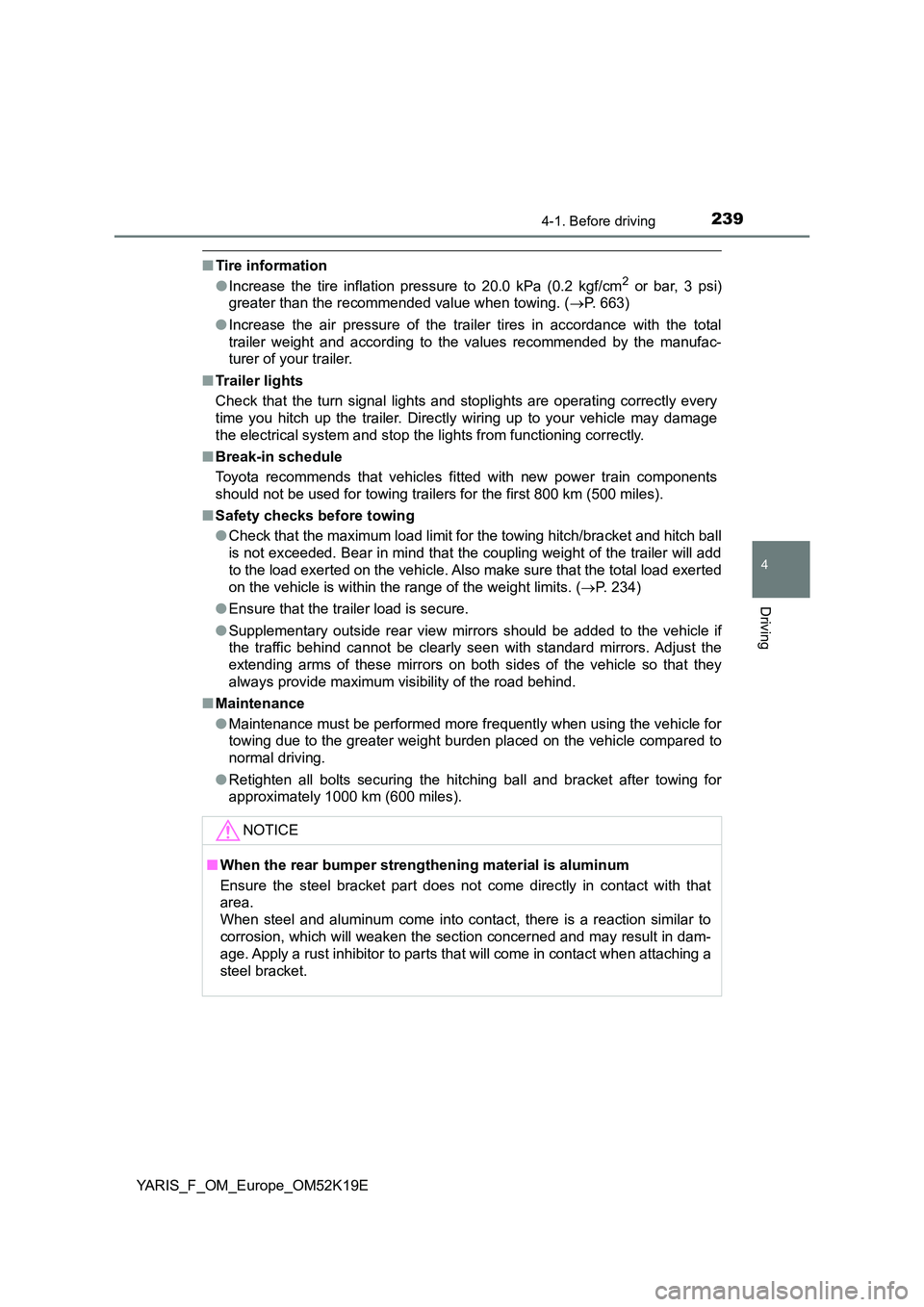
2394-1. Before driving
4
Driving
YARIS_F_OM_Europe_OM52K19E
■Tire information
● Increase the tire inflation pressure to 20.0 kPa (0.2 kgf/cm2 or bar, 3 psi)
greater than the recommended value when towing. ( P. 663)
● Increase the air pressure of the trailer tires in accordance with the total
trailer weight and according to the values recommended by the manufac-
turer of your trailer.
■ Tr a i l e r l i g h ts
Check that the turn signal lights and stoplights are operating correctly every
time you hitch up the trailer. Direct ly wiring up to your vehicle may damage
the electrical system and stop the lights from functioning correctly.
■ Break-in schedule
Toyota recommends that vehicles fitted with new power train components
should not be used for towing trailers for the first 800 km (500 miles).
■ Safety checks before towing
● Check that the maximum load limit for the towing hitch/bracket and hitch ball
is not exceeded. Bear in mind that the coupling weight of the trailer will add
to the load exerted on the vehicle. Also make sure that the total load exerted
on the vehicle is within the range of the weight limits. ( P. 234)
● Ensure that the trailer load is secure.
● Supplementary outside rear view mirrors should be added to the vehicle if
the traffic behind cannot be clearly seen with standard mirrors. Adjust the
extending arms of these mirrors on both sides of the vehicle so that they
always provide maximum visibility of the road behind.
■ Maintenance
● Maintenance must be performed more frequently when using the vehicle for
towing due to the greater weight burden placed on the vehicle compared to
normal driving.
● Retighten all bolts securing the hitching ball and bracket after towing for
approximately 1000 km (600 miles).
NOTICE
■ When the rear bumper strengthening material is aluminum
Ensure the steel bracket part does not come directly in contact with that
area.
When steel and aluminum come into contact, there is a reaction similar to
corrosion, which will weaken the section concerned and may result in dam-
age. Apply a rust inhibitor to parts that will come in contact when attaching a
steel bracket.
Page 265 of 700
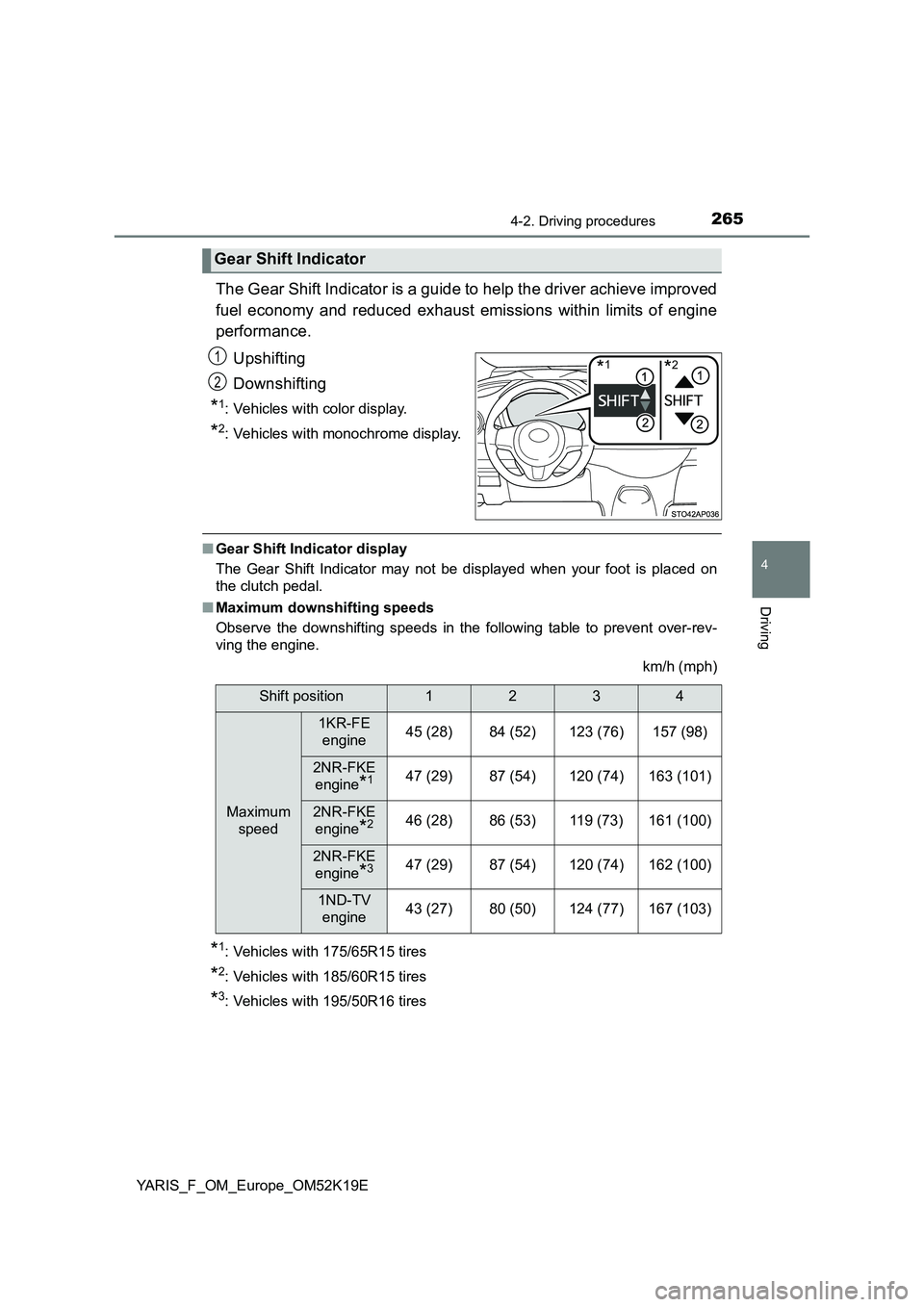
2654-2. Driving procedures
4
Driving
YARIS_F_OM_Europe_OM52K19E
The Gear Shift Indicator is a guide to help the driver achieve improved
fuel economy and reduced exhaust emissions within limits of engine
performance.
Upshifting
Downshifting
*1: Vehicles with color display.
*2: Vehicles with monochrome display.
■ Gear Shift Indicator display
The Gear Shift Indicator may not be displayed when your foot is placed on
the clutch pedal.
■ Maximum downshifting speeds
Observe the downshifting speeds in the following table to prevent over-rev-
ving the engine.
km/h (mph)
*1: Vehicles with 175/65R15 tires
*2: Vehicles with 185/60R15 tires
*3: Vehicles with 195/50R16 tires
Gear Shift Indicator
*1*21
2
Shift position1234
Maximum
speed
1KR-FE
engine45 (28)84 (52)123 (76)157 (98)
2NR-FKE
engine*147 (29)87 (54)120 (74)163 (101)
2NR-FKE
engine*246 (28)86 (53)119 (73)161 (100)
2NR-FKE
engine*347 (29)87 (54)120 (74)162 (100)
1ND-TV
engine43 (27)80 (50)124 (77)167 (103)
Page 296 of 700
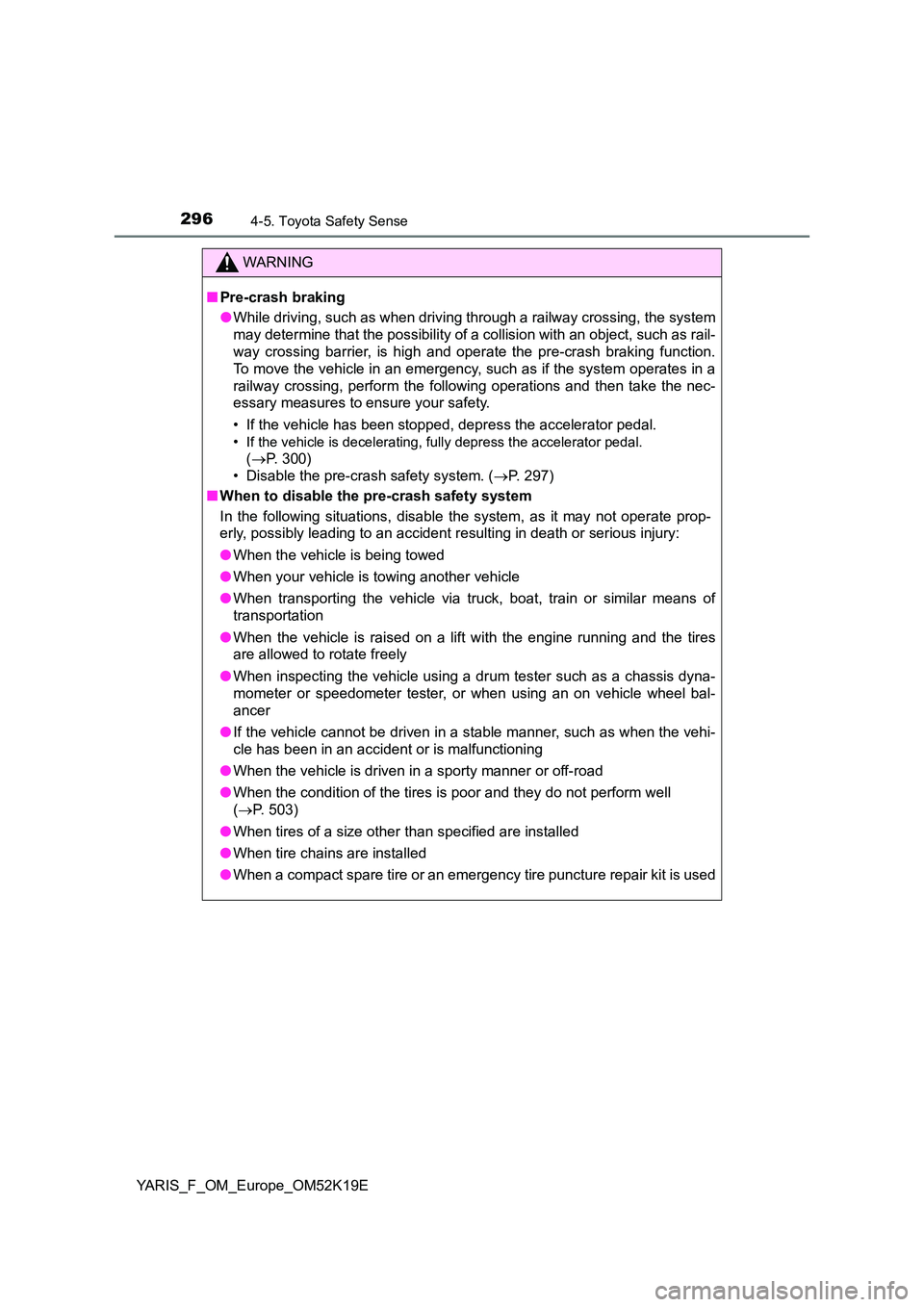
2964-5. Toyota Safety Sense
YARIS_F_OM_Europe_OM52K19E
WARNING
■Pre-crash braking
● While driving, such as when driving through a railway crossing, the system
may determine that the possibility of a collision with an object, such as rail-
way crossing barrier, is high and operate the pre-crash braking function.
To move the vehicle in an emergency, such as if the system operates in a
railway crossing, perform the following operations and then take the nec-
essary measures to ensure your safety.
• If the vehicle has been stopped, depress the accelerator pedal.
•If the vehicle is decelerating, fully depress the accelerator pedal.
( P. 300)
• Disable the pre-crash safety system. ( P. 297)
■ When to disable the pre-crash safety system
In the following situations, disable the system, as it may not operate prop-
erly, possibly leading to an accident resulting in death or serious injury:
● When the vehicle is being towed
● When your vehicle is towing another vehicle
● When transporting the vehicle via truck, boat, train or similar means of
transportation
● When the vehicle is raised on a lift with the engine running and the tires
are allowed to rotate freely
● When inspecting the vehicle using a drum tester such as a chassis dyna-
mometer or speedometer tester, or when using an on vehicle wheel bal-
ancer
● If the vehicle cannot be driven in a stable manner, such as when the vehi-
cle has been in an accident or is malfunctioning
● When the vehicle is driven in a sporty manner or off-road
● When the condition of the tires is poor and they do not perform well
( P. 503)
● When tires of a size other than specified are installed
● When tire chains are installed
● When a compact spare tire or an emergency tire puncture repair kit is used
Page 307 of 700
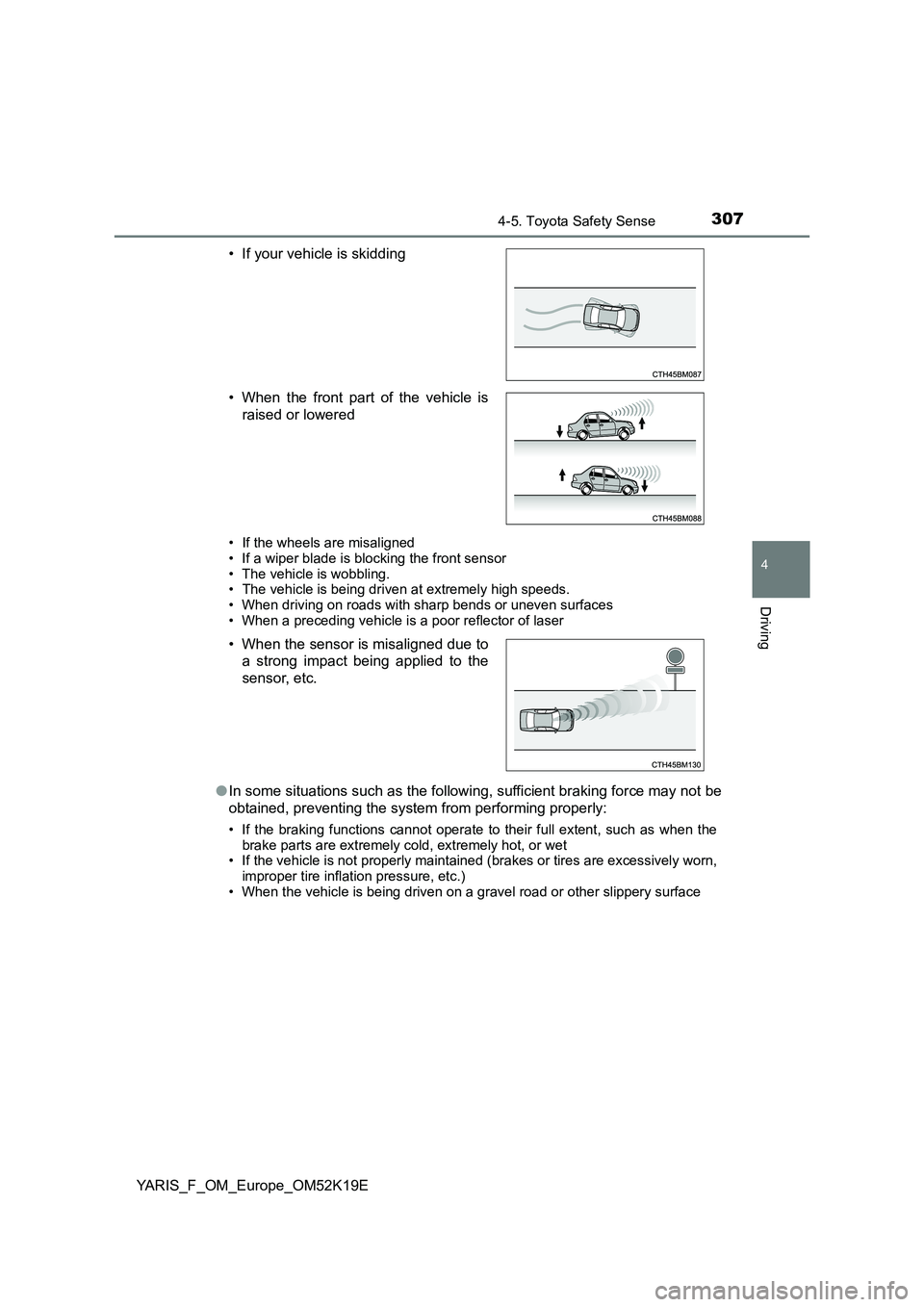
3074-5. Toyota Safety Sense
4
Driving
YARIS_F_OM_Europe_OM52K19E
• If the wheels are misaligned
• If a wiper blade is blocking the front sensor • The vehicle is wobbling.• The vehicle is being driven at extremely high speeds.
• When driving on roads with sharp bends or uneven surfaces • When a preceding vehicle is a poor reflector of laser
● In some situations such as the following, sufficient braking force may not be
obtained, preventing the system from performing properly:
• If the braking functions cannot operate to their full extent, such as when the brake parts are extremely cold, extremely hot, or wet• If the vehicle is not properly maintained (brakes or tires are excessively worn,
improper tire inflation pressure, etc.) • When the vehicle is being driven on a gravel road or other slippery surface
• If your vehicle is skidding
• When the front part of the vehicle is
raised or lowered
• When the sensor is misaligned due to
a strong impact being applied to the
sensor, etc.
Page 315 of 700
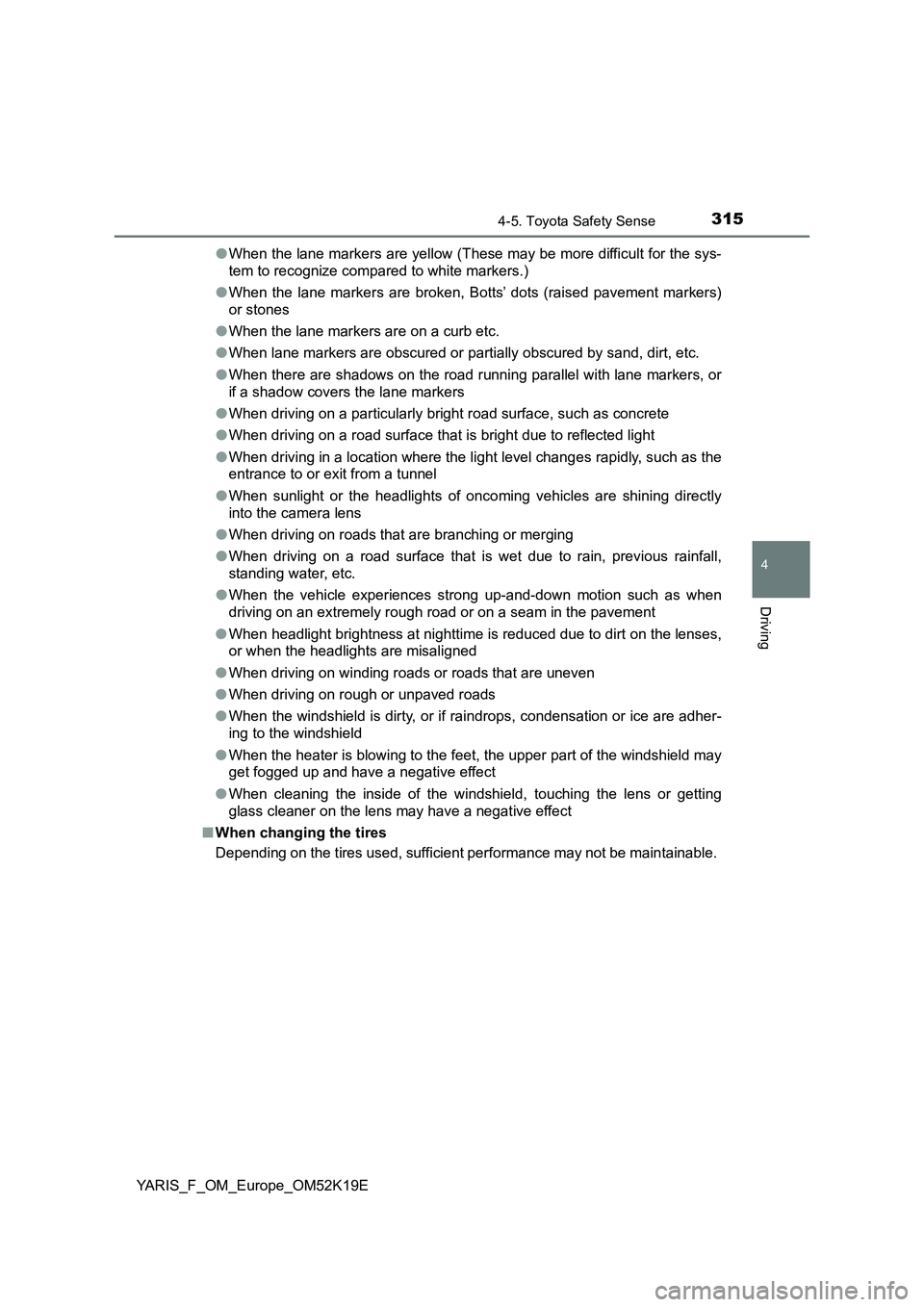
3154-5. Toyota Safety Sense
4
Driving
YARIS_F_OM_Europe_OM52K19E
● When the lane markers are yellow (These may be more difficult for the sys-
tem to recognize compared to white markers.)
● When the lane markers are broken, Botts’ dots (raised pavement markers)
or stones
● When the lane markers are on a curb etc.
● When lane markers are obscured or partially obscured by sand, dirt, etc.
● When there are shadows on the road running parallel with lane markers, or
if a shadow covers the lane markers
● When driving on a particularly bright road surface, such as concrete
● When driving on a road surface that is bright due to reflected light
● When driving in a location where the light level changes rapidly, such as the
entrance to or exit from a tunnel
● When sunlight or the headlights of oncoming vehicles are shining directly
into the camera lens
● When driving on roads that are branching or merging
● When driving on a road surface that is wet due to rain, previous rainfall,
standing water, etc.
● When the vehicle experiences strong up-and-down motion such as when
driving on an extremely rough road or on a seam in the pavement
● When headlight brightness at nighttime is reduced due to dirt on the lenses,
or when the headlights are misaligned
● When driving on winding roads or roads that are uneven
● When driving on rough or unpaved roads
● When the windshield is dirty, or if raindrops, condensation or ice are adher-
ing to the windshield
● When the heater is blowing to the feet, the upper part of the windshield may
get fogged up and have a negative effect
● When cleaning the inside of the windshield, touching the lens or getting
glass cleaner on the lens may have a negative effect
■ When changing the tires
Depending on the tires used, sufficient performance may not be maintainable.
Page 353 of 700
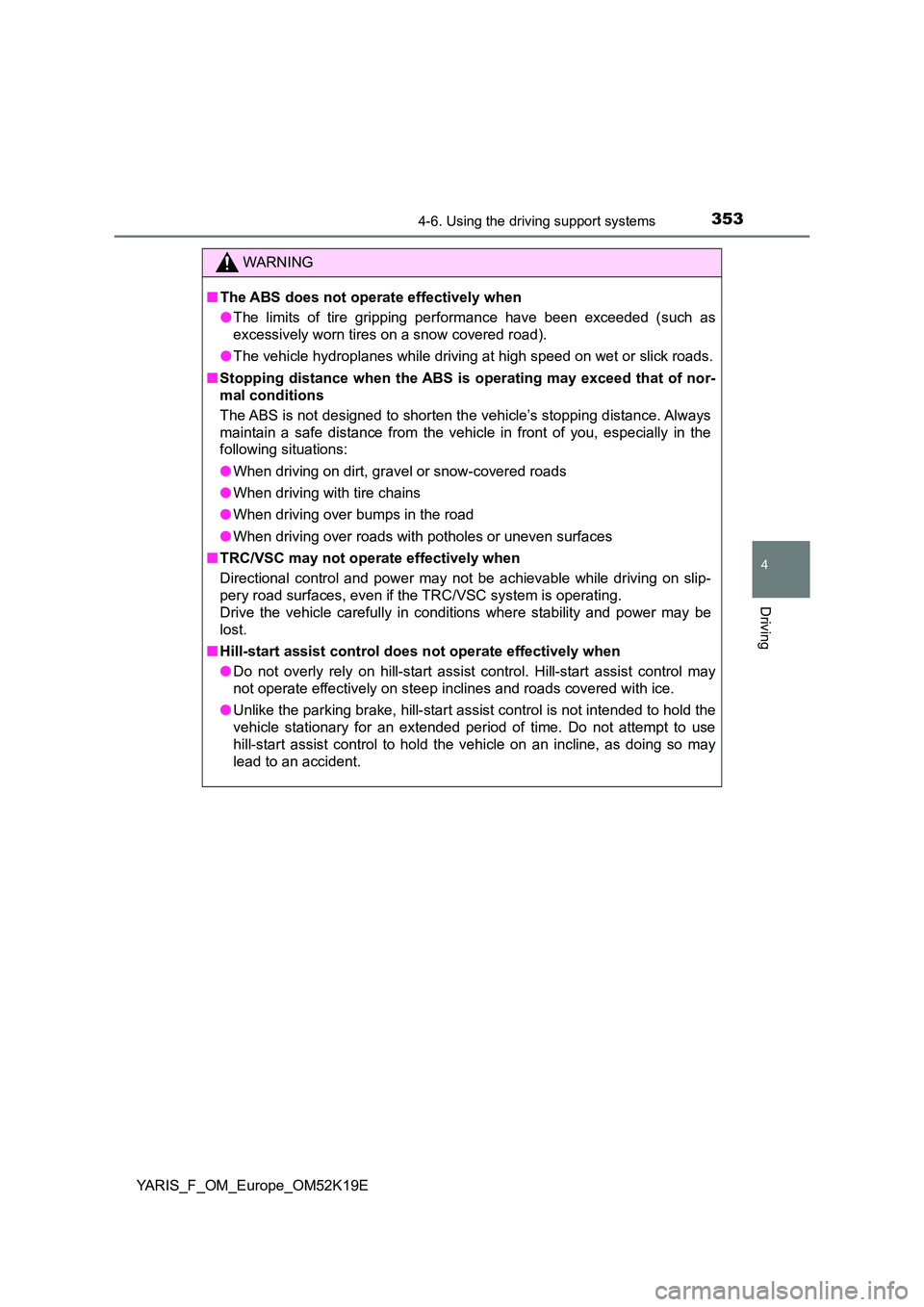
3534-6. Using the driving support systems
4
Driving
YARIS_F_OM_Europe_OM52K19E
WARNING
■The ABS does not operate effectively when
● The limits of tire gripping performance have been exceeded (such as
excessively worn tires on a snow covered road).
● The vehicle hydroplanes while driving at high speed on wet or slick roads.
■ Stopping distance when the ABS is operating may exceed that of nor-
mal conditions
The ABS is not designed to shorten t he vehicle’s stopping distance. Always
maintain a safe distance from the vehicle in front of you, especially in the
following situations:
● When driving on dirt, gravel or snow-covered roads
● When driving with tire chains
● When driving over bumps in the road
● When driving over roads with potholes or uneven surfaces
■ TRC/VSC may not operate effectively when
Directional control and power may not be achievable while driving on slip-
pery road surfaces, even if the TRC/VSC system is operating.
Drive the vehicle carefully in conditions where stability and power may be
lost.
■ Hill-start assist control does not operate effectively when
● Do not overly rely on hill-start assist control. Hill-start assist control may
not operate effectively on steep inclines and roads covered with ice.
● Unlike the parking brake, hill-start assist control is not intended to hold the
vehicle stationary for an extended period of time. Do not attempt to use
hill-start assist control to hold the vehicle on an incline, as doing so may
lead to an accident.
Page 354 of 700
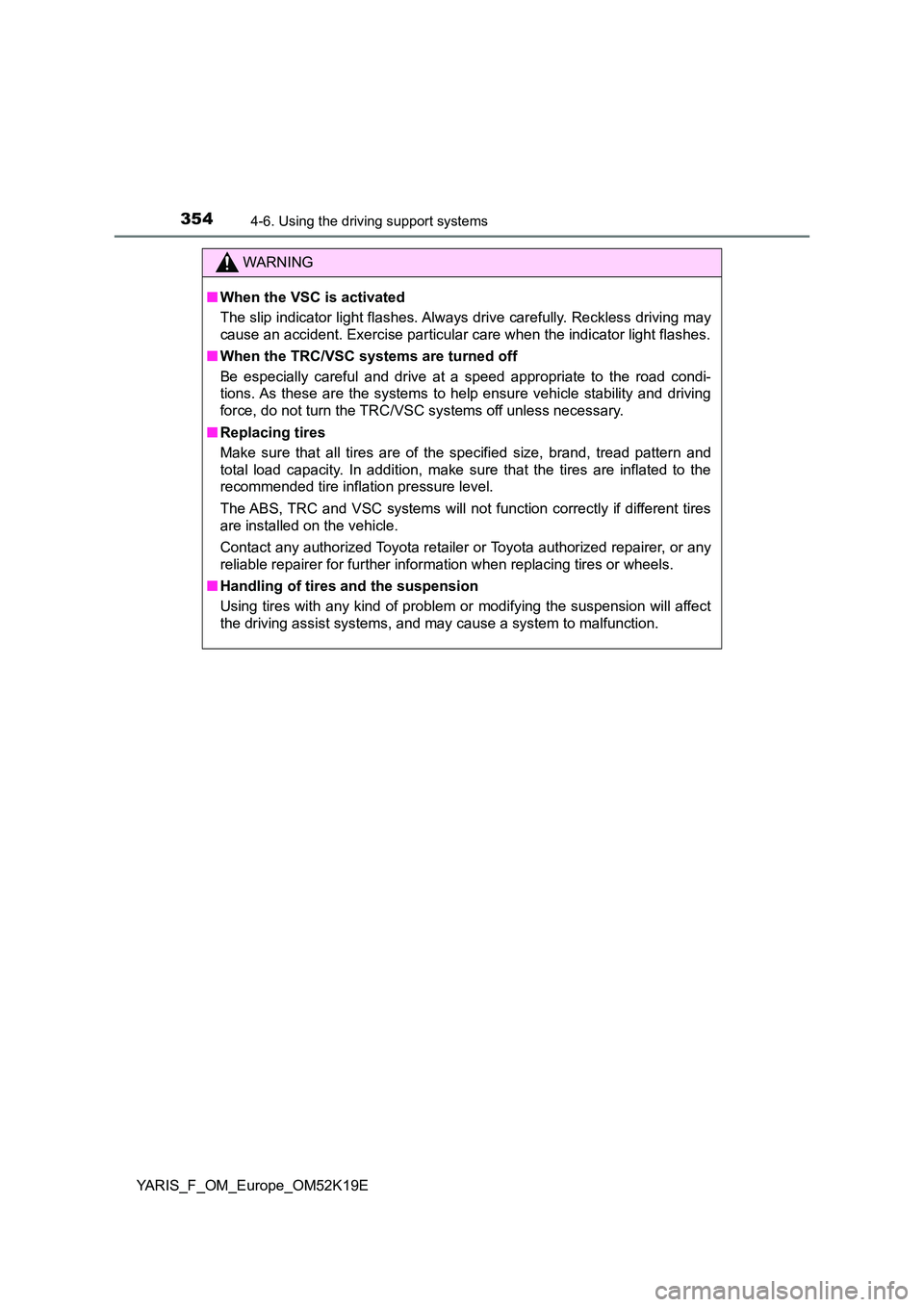
3544-6. Using the driving support systems
YARIS_F_OM_Europe_OM52K19E
WARNING
■When the VSC is activated
The slip indicator light flashes. Always drive carefully. Reckless driving may
cause an accident. Exercise particular care when the indicator light flashes.
■ When the TRC/VSC systems are turned off
Be especially careful and drive at a speed appropriate to the road condi-
tions. As these are the systems to help ensure vehicle stability and driving
force, do not turn the TRC/VSC systems off unless necessary.
■ Replacing tires
Make sure that all tires are of the specified size, brand, tread pattern and
total load capacity. In addition, make sure that the tires are inflated to the
recommended tire inflation pressure level.
The ABS, TRC and VSC systems will not function correctly if different tires
are installed on the vehicle.
Contact any authorized Toyota retailer or Toyota authorized repairer, or any
reliable repairer for further information when replacing tires or wheels.
■ Handling of tires and the suspension
Using tires with any kind of problem or modifying the suspension will affect
the driving assist systems, and may cause a system to malfunction.